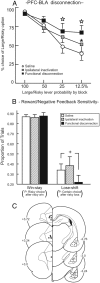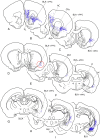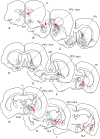Separate prefrontal-subcortical circuits mediate different components of risk-based decision making
- PMID: 22357871
- PMCID: PMC3609657
- DOI: 10.1523/JNEUROSCI.5625-11.2012
Separate prefrontal-subcortical circuits mediate different components of risk-based decision making
Abstract
Choosing between smaller, assured rewards or larger, uncertain ones requires reconciliation of competing biases toward more certain or riskier options. We used disconnection and neuroanatomical techniques to reveal that separate, yet interconnected, neural pathways linking the medial prefrontal cortex (PFC), the basolateral amygdala (BLA), and nucleus accumbens (NAc) contribute to these different decision biases in rats. Disrupting communication between the BLA and NAc revealed that this subcortical circuit biases choice toward larger, uncertain rewards on a probabilistic discounting task. In contrast, disconnections between the BLA and PFC increased choice of the Large/Risky option. PFC-NAc disconnections did not affect choice but did increase choice latencies and trial omissions. Neuroanatomical studies confirmed that projection pathways carrying axons from BLA-to-PFC transverse a distinctly different route relative to PFC-to-BLA pathways (via the ventrolateral amydalofugal pathway and ventromedial internal capsule, respectively). We exploited these dissociable axonal pathways to selectively disrupt bottom-up and top-down communication between the BLA and PFC. Subsequent disconnection studies revealed that disruption of top-down (but not bottom-up) information transfer between the medial PFC and BLA increased choice of the larger, riskier option, suggesting that this circuit facilitates tracking of actions and outcomes to temper urges for riskier rewards as they become less profitable. These findings provide novel insight into the dynamic competition between these cortical/subcortical circuits that shape our decision biases and underlie conflicting urges when evaluating options that vary in terms of potential risks and rewards.
Figures








References
-
- Bacon SJ, Headlam AJ, Gabbott PL, Smith AD. Amygdala input to medial prefrontal cortex (mPFC) in the rat: A light and electron microscope study. Brain Res. 1996;720:211–219. - PubMed
-
- Balleine BW, Killcross S. Parallel incentive processing: an integrated view of amygdala function. Trends Neurosci. 2006;29:272–279. - PubMed
-
- Blair K, Marsh AA, Morton J, Vythilingam M, Jones M, Mondillo K, Pine DC, Drevets WC, Blair JR. Choosing the lesser of two evils, the better of two goods: specifying the roles of ventromedial prefrontal cortex and dorsal anterior cingulate in object choice. J Neurosci. 2006;26:11379–11386. - PMC - PubMed
Publication types
MeSH terms
Substances
Grants and funding
LinkOut - more resources
Full Text Sources
Other Literature Sources
Miscellaneous
